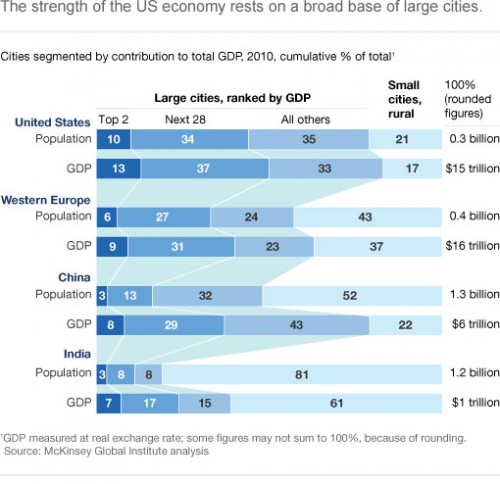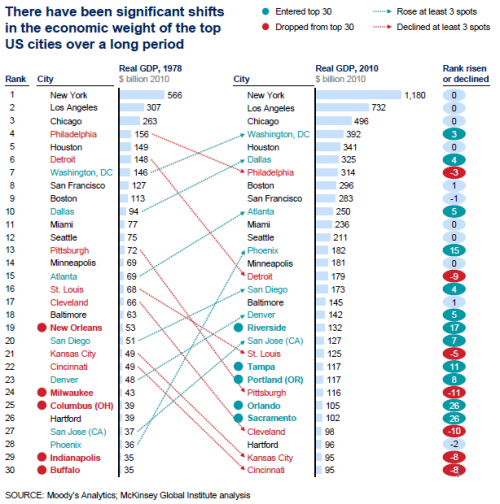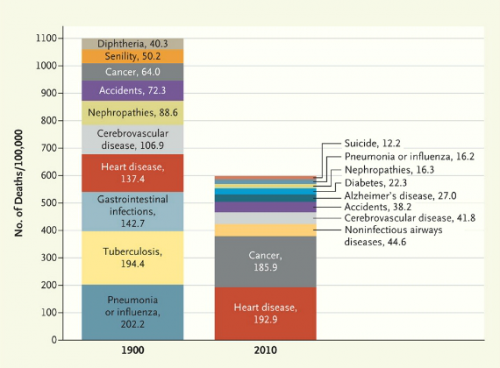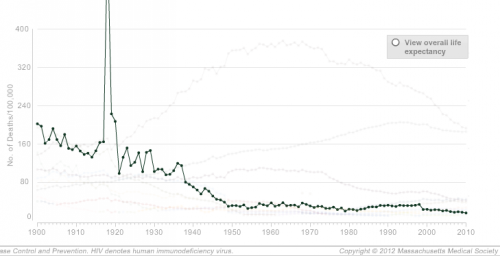For those readers who teach statistics, or methods, or cover the representation of data in their classes, or, like me, are just geeky and unfortunately easily amused, I present to you The World’s Most Accurate Pie Chart.
Gwen Sharp is an associate professor of sociology at Nevada State College. You can follow her on Twitter at @gwensharpnv.Peter Nardi, from Pitzer College, let us know that the McKinsey Global Institute recently released a report on U.S. cities and the economy. Large cities (those with 150,000+ residents), are more dominant in the U.S. than in Western Europe, China, and India. More of both the national population and economic productivity (measured by GDP) is concentrated in cities in the U.S. than in those other areas, with the exception of the concentration of GDP in large cities in China:
So overall, the vast majority of the U.S. population lives in cities, and they drive economic development and change here. But of course, the fortunes of cities within the U.S. have varied greatly. If we look at the top 30 cities (by GDP) in 1978 and 2010 (in constant 2010 dollars), we can see the decline of many older manufacturing and transportation centers in the northeast and Great Lakes areas. Milwaukee, Indianapolis, Columbus, and Buffalo fell out of the top 30 altogether, while Philly, Detroit, Pittsburgh, Cleveland, and Cincinnati experienced decreases in their contributions to the overall economy, as did three river port cities — New Orleans, Kansas City, and St. Louis. On the other hand, the Sun Belt has become much more prominent, with cities in the South and Southwest entering the top 30 or rising in the rankings (and 6 of the top 30 from California alone):
Most of the economic growth, the study finds, is due to expanding populations. Large cities aren’t becoming much more productive — cities with high overall GDP growth didn’t have higher per capita growth rates than other cities, so it isn’t that their economies are transforming in ways that make workers tremendously more productive individually. They’re growing much faster in terms of population, and that expansion pushes economic growth.
The report also found there’s no single path to successful economic growth for cities. Some with diversified local economies did very well, but others were below average; similarly, some cities that were largely dependent on just one or two economic sectors have suffered, but others did quite well. Check out the full report for a much more detailed analysis on the factors that influence the rise or decline of the economies of U.S. cities, as well as future challenges.
(Via The Atlantic.)
YetAnotherGirl sent us a link to a post at Jezebel about a sign MarketFair Mall, in New Jersey, put up (and then took down after criticism and a petition) to apologize for any inconvenience some remodeling might cause:
The sign does a couple of things. It normalizes the idea that the type of verbal harassment women often face when in public (see my post from a couple of years ago for a personal example) is, in fact, the natural outcome of how women look. Rather than feeling harassed, women should interpret such comments as the compliments they really are. Yes, yes, we can shake our heads and act annoyed, but isn’t it ultimately nice to know we look good?
The sign also reinforces a certain view of working-class masculinity, one in which working-class men are crude and lacking in basic civility, unable or unwilling to control how they express themselves, a fact that everyone else may find a bit irritating but should ultimately shrug off with a bit of a smile.
This view of working-class masculinity is reinforced in a Dutch commercial sent in by Sarah van B. The commercial is for Gamma, a chain of hardware stores in the Netherlands. In it, boys build houses out of Legos, displaying various stereotypes of rough, brutish masculinity: lack of middle-class manners (burping, nose-picking), uncontrolled bodies (belly hanging out, visible butt crack), and group harassment of women:
Sarah translates the call to the woman as “Where are those pretty little legs going?”
Such depictions normalize the harassment of women while also associating it with a general lack of sophistication, something that only the lower classes would engage in. They encourage the audience to laugh at the men who do so, finding humor in their brutish antics, but also reinforce the idea that women should just expect this type of behavior from the type of men who do manual labor.
The Washington Post has provided an image from the New England Journal of Medicine that illustrates changing causes of death. Comparing the top 10 causes of death in 1900 and 2010 (using data from the Centers for Disease Control and Prevention), we see first that mortality rates have dropped significantly, with deaths from the top 10 causes combined dropping from about 1100/100,000 to about 600/100,000:
And not surprisingly, what we die from has changed, with infectious diseases decreasing and being replaced by so-called lifestyle diseases. Tuberculosis, a scourge in 1900, is no longer a major concern for most people in the U.S. Pneumonia and the flu are still around, but much less deadly than they used to be. On the other hand, heart disease has increased quite a bit, though not nearly as much as cancer.
The NEJM has an interactive graph that lets you look at overall death rates for every decade since 1900, as well as isolate one or more causes. For instance, here’s a graph of mortality rates fro pneumonia and influenza, showing the general decline over time but also the major spike in deaths caused by the 1918 influenza epidemic:
The graphs accompany an article looking at the causes of death described in the pages of NEJM since its founding in 1812; the overview highlights the social context of the medical profession. In 1812, doctors had to consider the implications of a near-miss by a cannonball, teething could apparently kill you, and doctors were concerned with a range of fevers, from bilious to putrid. By 1912, the medical community was explaining disease in terms of microbes, the population had gotten healthier, and an editorial looked forward to a glorious future:
Perhaps in 1993, when all the preventable diseases have been eradicated, when the nature and cure of cancer have been discovered, and when eugenics has superseded evolution in the elimination of the unfit, our successors will look back at these pages with an even greater measure of superiority.
As the article explains, the field of medicine is inextricably connected to larger social processes, which both influence medical practice and can be reinforced by definitions of health and disease:
Disease definitions structure the practice of health care, its reimbursement systems, and our debates about health policies and priorities. These political and economic stakes explain the fierce debates that erupt over the definition of such conditions as chronic fatigue syndrome and Gulf War syndrome. Disease is a deeply social process. Its distribution lays bare society’s structures of wealth and power, and the responses it elicits illuminate strongly held values.
Cross-posted at Ms.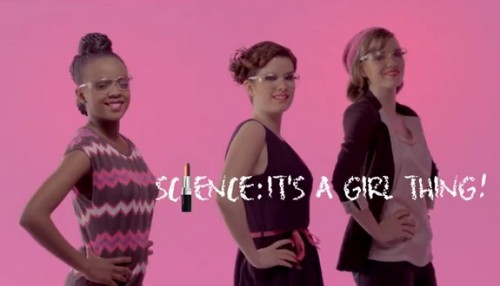
Paul (an Irish grad student), Carys G., Zeynep A., Marjan vdW., and one other reader all sent in a link to a new video released by the European Commission. The video, “Science: It’s a Girl Thing!”, is meant to encourage girls to consider careers in the natural and physical sciences, presenting science, as the title suggests, as an area compatible with femininity and other “girl things” — make-up, high heels, and fashion:
The video has been roundly criticized (check out the Twitter feed for #sciencegirlthing), both for presenting a stereotyped image of girls and for misrepresenting the scientific workplace (one female scientist Tweeted wondering what will happen to any girls possibly drawn in by this campaign when they learn that in many labs, open-toed heels violate safety codes).
I suspect the makers of the video believe they are doing that first thing — trying to push back against the idea that science is unfeminine. Indeed, the video is part of the larger Science: It’s a Girl Thing! campaign, and the website also contains 12 profiles of female European scientists, which provide more realistic depictions of women working in a range of scientific fields. But many viewers, including a lot of scientists (both women and men), see it as the second thing — another example of what I described in my original post of the cartoon as “superficial attempts to overcome the often structural constraints that keep women out of masculinized arenas of social life.”
Indeed, girls don’t just need to be told “you can do science and look cute too!” In fact, a post at New Scientist discusses the results of a recently-published article by Diana Betz and Denise Sekaquaptewa, “My Fair Physicist? Feminine Math and Science Role Models Demotivate Young Girls”. Betz and Sekaquaptewa found that images of conventionally feminine women in science fields actually demotivated female middle school students and decreased their perceptions of their likelihood of success in science and math. Girls appeared to see these images and, instead of thinking “Oh, I can like makeup and clothes but still do science!”, they thought, not unreasonably, “Oh, great, so I have to be smart and still meet all the demands of conventional femininity, too?” Instead of inspiring girls, the images were threatening, making them feel less likely to succeed in science and math. This effect was most pronounced for those girls who weren’t already interested in such fields — presumably the exact group campaigns such as Science: It’s a Girl Thing! are meant to attract. As the authors conclude (p. 7), “Submitting STEM role models to Pygmalian-style makeovers…may do more harm than good.”
Gwen Sharp is an associate professor of sociology at Nevada State College. You can follow her on Twitter at @gwensharpnv.Earlier this month, Louisiana’s legislature voted to expand its school voucher program to cover the entire state, allowing parents whose children attend low-rated schools to use government-funded vouchers to help pay the cost of tuition at one of about 125 schools on an approved list (assuming, of course, their child is accepted). Another law recently passed in the state will provide tax credits for private donations to voucher programs, a policy already implemented in some states, including Pennsylvania.
Critics have expressed concern about some of the schools approved for the program, including a lack of site visits in the approval process and the inclusion of schools that do not appear to have the facilities or staff for the large increases in enrollment that would result if all of their available vouchers were used.
The expansion of the voucher program has also brought renewed attention to the curricula used at schools receiving state funds through voucher systems. Some of the schools approved for the voucher program in Louisiana, as well as other states, use textbooks produced by several evangelical organizations, including A Beka Book and Bob Jones University. In the documentary School Choice: Taxpayer-Funded Creationism, Bigotry, and Bias, Rachel Tabachnick and Bruce Wilson discuss Pennsylvania’s voucher program. Here’s an 8-minute clip focusing on the contents of some textbooks published by A Beka Book and BJU:
Examples from A Beka Book and Bob Jones University Press Curricula from Bruce Wilson on Vimeo.
Highlights:
- Humans and dinosaurs co-existed.
- God designed “checks and balances” to prevent environmental crises, so chill! After all, “Roses are red, violets are blue; they both grow better with more CO2.”
- “Rumors” of foreclosures, high unemployment, homelessness, and general misery during the Great Depression are just socialist propaganda.
- Unions just want to destroy the accomplishments of “hardworking Americans.”
- Mormons, Unitarians, and Catholics = bad.
- And then there’s the history of racial/ethnic relations: “God used the ‘Trail of Tears’ to bring many Indians to Christ” and “Through the Negro spiritual, slaves developed patience to wait on the Lord and discovered that the truest freedom is freedom from the bondage of sin.” No, seriously — I didn’t make those up.
You can read some additional examples in a recent post at Salon, including the following:
Are dinosaurs alive today? Scientists are becoming more convinced of their existence. Have you heard of the `Loch Ness Monster’ in Scotland? `Nessie,’ for short has been recorded on sonar from a small submarine, described by eyewitnesses, and photographed by others. Nessie appears to be a plesiosaur.
Schools using these texts have been approved to receive government funds for education. It highlights one of critics’ concerns about voucher programs: that it is, in effect, often a way to provide taxpayer-funded education that is explicitly religious and may or may not conform to accepted standards of scientific inquiry.
Here’s the full-length documentary:
School Choice: Taxpayer-Funded Creationism, Bigotry, and Bias from Rachel Tabachnick on Vimeo.
Also see our earlier post on a Texas textbook standards advisor explaining that books should emphasize the positive, such as how minorities ought to be really grateful to Whites for giving them rights.
One of our readers sent in an example of our cultural tendency to conflate “ethnic” with “non-white,” a conflation that renders whiteness invisible in discussions of race/ethnicity and its social impacts. You Beauty posted a slideshow about choosing an appropriate sunscreen, and the first slide highlights two that are “best for ethnic skin.” The accompanying text refers to “deeper skin tones” and includes a link to a story on “dark skin decoded”:
It’s a small example of the way that race and ethnicity are perceived more broadly in our culture, with whiteness taken as the neutral, as the absence of noticeable race/ethnicity, while “ethnic” is the marked, non-neutral state of all those who aren’t white.
This weekend I read an article in Bitch magazine about Project Unbreakable. Last fall, then 19-year-old Grace Brown began photographing survivors of sexual assault holding posters with quotes from their attackers (or, in some cases, the police or others they told about the attack). It’s a powerful art project that highlights the emotional manipulation (“I love you,” or “If you tell your mom she’ll hate you for causing us to break up”) that often accompanies rape and sexual abuse. Collectively they illustrate many of the justifications perpetrators give. The quotes chosen by the survivors also make clear that the demands to keep the incident secret and the efforts of abusers to justify their behavior are as much a part of the attack as the physical element.
Gwen Sharp is an associate professor of sociology at Nevada State College. You can follow her on Twitter at @gwensharpnv.
